Onion maggot control
Learn about onion maggot life history, damage and control.
Introduction
The onion maggot is the most damaging insect pest of onions throughout the northern areas where onions are grown. If not controlled, it can prevent the production of a marketable crop. In Ontario, the onion maggot has become difficult to control. Resistance has developed to many of the insecticides used as granular furrow treatments at seeding for control of early season damage.
Description and Life History
The onion maggot passes the winter in the soil in a dormant stage, the pupa. Pupae are brownish in colour, oval and slightly larger than a grain of wheat (Figure 1). As soon as the weather warms up in spring, the pupae develop into adults which emerge in mid-to-late-May in the onion-growing areas of Ontario. These adults are grayish and look something like the common housefly except that the onion maggot has larger legs and a narrower abdomen (Figure 2). They are twice the size of seed corn maggot flies and just slightly larger than cabbage maggot flies. Cabbage maggot flies have 2 dark bands on the upper thorax unlike onion maggot flies.
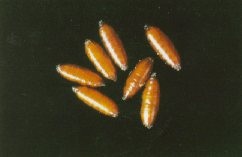
Figure 1. Pupae of the onion maggot.
During late May and June onion maggot flies will be seen in the onion fields and often on dandelions around the field borders. Adults mate when they are about 6 days old and begin laying eggs after an additional 3 to 4 days.
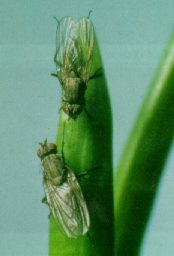
Figure 2. Onion maggot adult.
Each female will live about 30 days, and during that time may lay up to 200 eggs. Eggs are laid in about 3 batches, with a few days between each batch during which time no eggs are deposited. The eggs are white, elongate and small (Figure 3). They are usually laid around the base of the small onion seedlings but as the plants become larger, and especially during dry weather, they may be laid in the leaf sheaths. Eggs hatch in a few days and the larvae bore directly into the onion plant. These larvae are tiny, white, legless maggots that taper toward the front end (Figure 4). They grow to a length of about 1 cm when mature, and have conspicuous dark feeding "hooks" on the tapered end. They may attack the onion at any stage of development and feed within the plant for about 2 to 3 weeks. When the larva becomes full grown it leaves the onion and pupates in the soil.
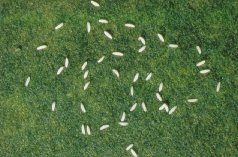
Figure 3. Eggs of the onion maggot.
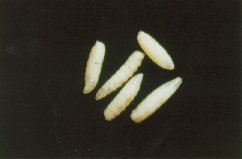
Figure 4. Larvae of the onion maggot.
In Ontario, there are three generations each year (Figure 5). Adults of the first generation are present from mid-May to late June. Second generation adults appear in early July and continue into early August, while the third generation adults are present from late August to early October.
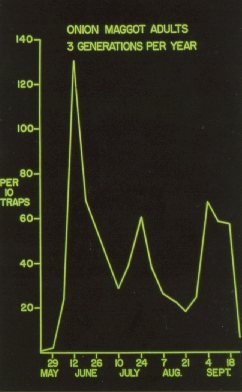
Figure 5. Trap catches showing three generations of adults/year.
Damage
Damage from the first generation attack usually can be seen in mid-to-late June as wilted onion seedlings (Figure 6). If you try to pull the wilted plant, it is likely to break just below the rotting stem of the seedling. Quite often the seedling dies before the maggot is full-grown. When this occurs the maggot will move down the row to the next seedling.
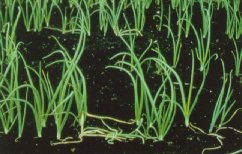
Figure 6. Damage to onion seedlings.
This, plus the fact that the adult seems to lay its eggs in batches, results in damage appearing as dying patches in a row rather than as single plants.
When the second generation attacks in July the onions have begun to form bulbs and feeding by larvae does not kill the plants. Damage can be determined by pulling the plants and observing the maggot infestation. Plants damaged at this time will result in grossly misshapen onions that are not suitable for market. In addition, secondary rots may set in following the onion maggot damage and the bulb will be totally destroyed.
By the time the third generation of flies is laying eggs, most of the onions will be in windrows drying. The eggs will be laid directly on the bulbs or on the soil immediately next to and beneath the drying onions. Maggots hatching from these eggs can bore into the onion bulb at any point, but tend to enter around the root areas. These maggots will be taken with the onions to storage with the result that both direct damage from the maggots and secondary storage rots cause heavy losses of marketable onions.
Control
Good sanitation is extremely important in controlling the onion maggot. In order for third generation maggots to survive and overwinter in the field, they must have a supply of cull or missed onions on which to feed. If all onions are removed from the field, the maggots will have nothing on which to feed and thus cannot survive. Growers should, therefore, do their best to ensure complete harvesting and to leave no culls in the field. Removal of cull piles is also strongly encouraged. Limited natural control of the onion maggot is provided by a complex of predators and parasitoids which include the predatory flies Coenosia tigrina and Scatophaga stercoraria, the wasp, Aphaerata pallipes, the beetle Aleochara bilineata and a fungus Entomopthora muscae.
The most important aspect of chemical control with insecticides is the granular application at planting or insecticide seed treatments. The insecticides recommended in OMAFRA Publication 363, Vegetable Production Recommendations, will provide good control for first and second generation maggots provided the rate is correct and the insecticide is placed in the furrow properly with the seed. Poor placement of the insecticide or reduced rates will result in maggot damage, while excessive dosages will cause plant injury.
Where granular treatments are not providing good control and where fly populations are high, sprays against the adults may also be needed. This is especially true for the third generation adults since much of the granular insecticide applied at planting will have disappeared by this time and onions in windrows have no protection.
In the past, growers applied sprays routinely on a weekly basis beginning when the onion maggot flies first appeared. This resulted in excessive use of insecticides, high costs, encouraged resistance development and often did not provide adequate control. It has been demonstrated that good control can be achieved with a few (1 to 3) sprays timed to hit the peak population of flies. The timing for such sprays can be based on trap catches or on the basis of temperature. A combination of the two methods is probably best. The development of the maggot can be predicted by keeping a good record of temperature. The maggot does not develop unless the temperature is above 4°C. Above this temperature, however, the growth rate is proportional to temperature. Thus, the maggot develops the same amount in 2 days at a temperature of 19°C as it would in 6 days at a temperature of 9°C. These heat units are referred to as "degree days". By calculating the accumulated degree days as the season advances, one can predict when adult flies will appear, when they will mate and when eggs will be laid. Trap catches from monitored fields can confirm some of this information. By knowing this, one can determine when a spray application will be most helpful in reducing the number of flies capable of laying eggs. Note that foliar sprays have proven to be ineffective at reducing overall damage from onion maggot, especially in dry, cooking onions. Sprays for peak adult fly activity may be helpful for green onions or pickling onions.
Traps for adult flies do not need to be placed in every onion field on the farm, however, yellow, white or pale yellow traps are useful tools for gauging the trends in the fly population. Onion flies are not easy to identify on such traps and it is advisable to find someone who is familiar with identification to assist you. The degree day model is also useful at predicting when onion flies are active. In closely monitored fields, regular damage assessments after each generation and at harvest provide a very useful measurement of the effectiveness of your control strategies. In many cases, where the insecticide has worked properly, very few sprays for adults are needed and damage is kept to a minimum. For further information, contact you local Horticultural Crops Advisor and refer to the publication, Integrated Pest Management for Onions, Carrots, Celery and Lettuce in Ontario.